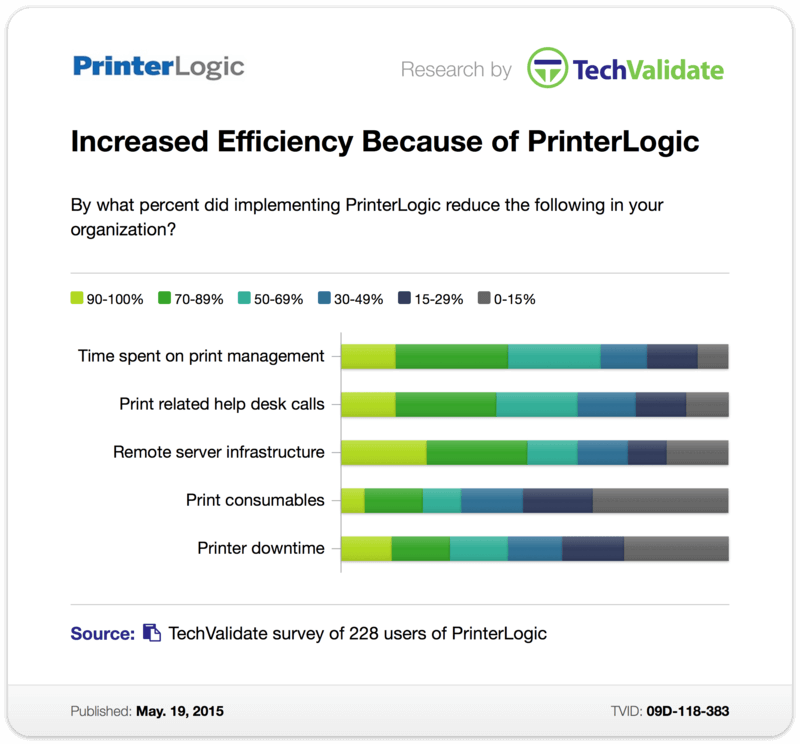Although breakups can be hard, we always love to see companies urging people to part ways with their print servers. We’ve been showing enterprises how to do that for a decade. For PrinterLogic, “Eliminate print servers!” is a battle cry we’ve been sounding for years.
And now that enterprise software giants like Microsoft are starting to break up with print servers, it’s a good time to look at solutions like Microsoft Universal Print and answer some important questions.
- Does Universal Print and it’s features meet the demands of modern enterprise organizations?
- How does Universal Print differ from a true SaaS print management solution?
- Does it bring high availability to print environments?
- Can it provide platform-agnostic print management?
It’s Tied to Microsoft’s 365 ecosystem
Universal Print requires organizations to commit to Microsoft’s 365 cloud platform (formerly Office 365). They also have to be Windows 10 Enterprise or Education customers running the latest build. And they need to be using Azure AD too. That’s an awful lot of boxes to check.
Some cutting-edge companies might meet all those criteria off the bat. However, it also means that they’re tied to that ecosystem for the foreseeable future. In modern workplaces where flexibility is key, that’s not ideal.
PrinterLogic’s print-management software is platform agnostic. You can certainly use it to leverage all the benefits of Azure AD or Windows 10. But you’re not locked into either one.
WAN-dependent availability
The Achilles heel of many cloud-based printing solutions is the WAN. If there’s no Internet connection, computers and printers can’t talk to the cloud. If they can’t talk to the cloud, no one can print. Microsoft Universal Print isn’t immune to that limitation.
In fact, its FAQ explicitly states that Universal Print is not for high-availability scenarios.
By contrast, PrinterLogic SaaS uses a direct IP print management model. Workstation clients relay their jobs directly to printers. So even if the WAN goes down, all of your users can print without interruption. You get more uptime from less infrastructure.
Print job data doesn’t stay local
Print availability isn’t the only WAN-related drawback. Another problem with Universal Print’s approach is that print data has to cross the WAN to reach it. That means every single print job leaves your local network to get queued in Microsoft 365 data storage.
On top of being a serious security risk, that can really slow printing speeds. It also forces print traffic to fight for WAN bandwidth. That can lead to all your vital cloud traffic bottlenecking at the WAN.
With PrinterLogic SaaS, print jobs remain safely on the LAN. Furthermore, there’s no centralized print queue. That adds security by completely removing an easy, data-rich target for malicious actors.
A limited feature set…
For now, Universal Print is still in its preview phase. As a result, it’s missing important features like pull printing and mobile printing. There are also no badge release options for secure printing. In other words, it’s a few steps backward for companies that have been working to lock down and modernize their print environments.
PrinterLogic, on the other hand, has had functionality like advanced reporting, versatile secure release printing and easy-to-use mobile printing for years. There’s even a self-service portal for one-click printer installation. All these are mature features that tap into the inherent strengths of our serverless print management.
… and equally limited driver management
Because Microsoft Universal Print is so new, the promise of easy driver management is just that—a promise. Currently, only select Canon printers can claim to have “Universal Print Ready” status. Support for other makes and models of MFPs remains to be seen.
That’s not the case with PrinterLogic SaaS. It has a single repository that consolidates all the drivers in your print environment. Using PrinterLogic’s centralized Admin Console, IT staff can add, remove, update and even roll back printer drivers across the organization. And it works with any printer.
PrinterLogic is a true SaaS printing solution
While we’re psyched to see companies like Microsoft moving beyond on-prem print servers, Universal Print still carries a lot of legacy baggage.
Over a decade ago, PrinterLogic looked to the future to start building the next generation of printing. We’ve been empowering IT pros with centralized print management—plus plenty of other advanced features—without the need for print servers ever since.
If you’re looking for a proven, enterprise-grade direct IP printing solution, PrinterLogic SaaS should be top of your list. Why? Because your print management solution should create new possibilities—not lock you in or tie you down.
